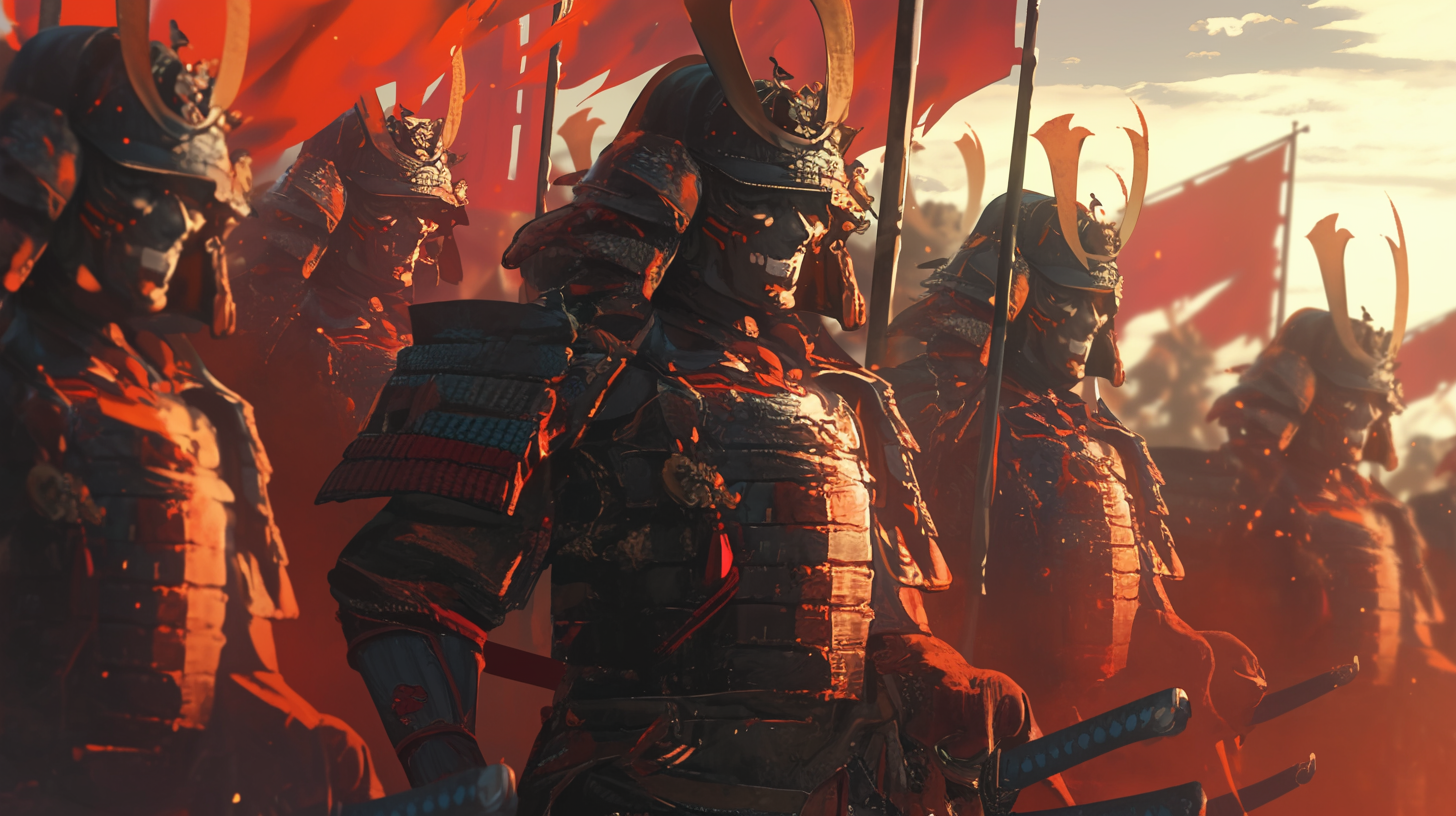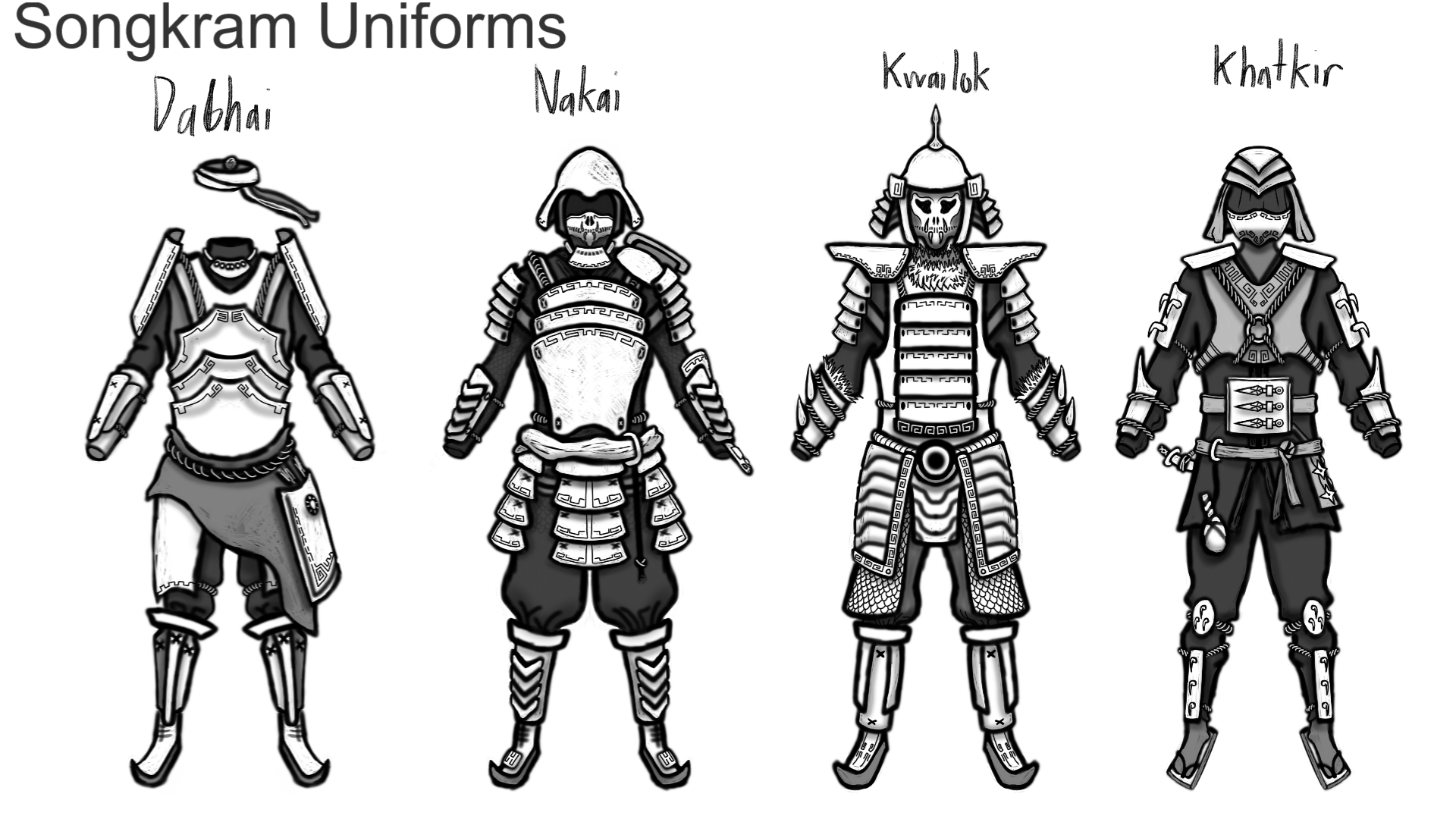Nakai
The nakai were the main military units of the Songkram Empire, the Ganpoumi Fi, and any other major Isutan power. They were highly trained, elite warriors taught from an extremely young age. Their loyalty and skill distinguished them for years against other military powers of Legere. Masters of the sword, bow, spear, and horse, nakai were exceptional combatants with whatever weapons they wielded.

Composition #
Manpower #
A typical nakai patrol consists of six soldiers. During peaceful times, nakai act as police, often patrolling streets at night to prevent crime. In wartime, 90 nakai are grouped into a haka under the command of a nakai master.
Command Structure #
Nakai are organized into 90-strong platoons known as hakas, commanded by nakai masters who report to grandmasters. Grandmasters report directly to the Songkram warlord or their respective Ganpoumi Fi councilman.
Nakai Masters and Biyuan #
Nakai masters are experienced combatants who also act as teachers. They handpick up to 10 nakai for their biyuan (personal squad), serving as personal guards and intermediaries.
Nakai Grandmasters and Silyuan #
Nakai grandmasters are the highest-ranking nakai, chosen by the Songkram Warlord or Ganpoumi Fi councilman. They manage the economy, advise political leaders, and select 10 nakai for their personal soldiers, known as a silyuan, where they would serve as personal bodyguards and messengers.
Training #
Under the Ganpoumi FI #
Anyone could join the nakai ranks by paying a training fee, which increased with age. Nakai students trained for 20 years, six days a week, in classes of 50. Upon completion, they would be tested by elder nakai warriors.
Under the Songkram #
The Songkram Empire employed strict and brutal training, including the annual Chatakerm tournament (also known as Fatefall or The Duelship in Tradespeak), where students fought to the death to graduate. By forcing young nakai to spill the blood of their classmates, the Songkram hoped to acclimatize their future soldiers to killing while also ensuring their allegiance was to the empire and not each other. ^02d851
To replenish ranks, the Songkram conscripted young children from neighboring villages on a biannual basis.
Logistics #
Auxilia #
Nakai relied on the support of other specialists:
- Khatkir: Special agents, assassins, and intelligence officers.
- Dabhai: Warrior-blacksmiths trained in weaponsmithing and armorsmithing.
- Mabosa: Hedge mages contracted to fight in battle.
- Footmen: Conscripted individuals used as sword-fodder in extreme conflicts.
Equipment #
Armour #
Nakai were equipped with starsteel armor plating, a lightweight but sturdy set of armor typically lacquered black or white to create uniformity among the ranks. Nakai could customize their armor with paint jobs, embellishments, and ornamentation after serving long enough or accomplishing great feats. Notably, nakai serving in biyuans or silyuans had less individuality in customization, instead adopting a stricter dress code set out by the grandmaster.
A thick red cord hung from their armor's waist, with knots tied into the cord to signify years of service. This allowed nakai to easily identify seniority.
Underneath the starsteel plate, nakai wore a tough cloth jacket for minor protection, similar to a gambeson, followed by a coat of starsteel chainmail and a loose cloth tunic underneath. This combination provided exceptional protection from many different weapons.
Nakai typically didn't use handheld shields, instead relying on a wide starsteel pauldron over their left shoulder for makeshift protection against projectiles[^1]. Their left bracer and hand guard were slightly larger to provide a form of offhand defense without the encumbrance of a shield, since many of the nakai weapons were polearms that required both hands to use. Nakai used miniature mantlets on the battlefield for cover when firing at the enemy.
Nakai would also wear masks that were created in the likeness of Pisaka. ![[Pisaka#^mask]]

Other tools found on nakai included:
- A trawl with sharpened edges for digging or as a backup weapon.
- A small jar of Fafly females to produce light.
- A drinking gourd and a flask of bitter alcohol for quick disinfectant[^2].
- Ryukeon Mushroom caps, used only by nakai willing to risk their effects--typically only employed during active warfare.
Weaponry #
Nakai had a wide array of weapons at their disposal, most employing starsteel in their construction. Starsteel was exceptionally strong and lightweight, leading to unique Isutan weapons that were larger and more dramatic in appearance.
Rauwing Polearm #
The rauwing was an iconic battlefield weapon with a 2-meter shaft and a scythe-like protrusion perpendicular to the shaft, useful for penetrating armour (like an elongated war pick), pulling riders off horses, and breaking shield walls. The top and bottom of the war pick were sharpened from the base to the midpoint, allowing it to have some moderate cutting power.
Certain rauwings were fitted with a smaller pick head on the back of the primary striking point. Other models included a spearhead mounted to the end of the shaft.
Because the striking head of the rauwing was often so large, rauwings were sometimes stored and transported with their head detached and tied to the shaft--they would need to be reassembled before battle.
Raujang Spear #
A straightforward 1.8-meter spear with a traditional spearhead and a heavy metal block on the other end. It had the strengths of a spear while also being able to crush armour at a moment's notice.
Ju Pe Bow #
Isutan bows were similar to non-Isutan bows.
Kizaraka Sword #
A single-edged, curved, two-handed sword worn at the side. It was the first weapon nakai were trained to use and was commonly associated with ceremonies. It was widely used in non-battlefield combat, like in urban peacekeeping, but still followed nakai into war as a sidearm.^1cc3e9
Uneonaka War Sword #
A larger, battlefield-friendly version of the kizaraka, but with a longer handle and blade. It was used against cavalry and in heavy combat.
Somaza Bludgeon #
A heavy, armour-crushing weapon, often made from hardwood coated in metal rivets. Some were made entirely metal. Somazas were most effective against heavy armour.
Rauming Gunspear #
A pole-mounted cannon that could be used as a powerful ranged weapon and an improvised mace in close quarters. It was decorated with engravings and often unreliable in wet weather. Some rauming models adopted the double-sided design of the Raujang Spear, but these models were never employed on the battlefield because the recoil could cause the spearpoint to injure comrades behind the firing line.
Vehicles and Mounted Combat #
Nakai were skilled in mounted combat, learning to ride and shoot while mounted. The later of which made them exceptionally famous across Legere. Nakai horses were often equipped with starsteel armor, providing protection without significant weight.
Retirement #
Once a nakai had reached 20 years of service, they had the option of retiring and being gifted a title of land by the government. Rice Town, and Jingho were two of the most popular destinations for retired nakai.
During the Songkram Empire's reign, the expansion of nakai forces caused the government to realize that there was a shortage of land and that there was little possibility that a wave of retiring nakai would be able to acquire property. This was one of the contributing factors to the start of the Spear of the West Campaign.
Footnotes #
[^1]: Magic from Djinnblades or Mabosa provided more thorough defenses when against superior ranged assailants. [^2]: The Ganpoumi Fi quickly found that nakai were drinking their disinfectant alcohol recreationally instead of using it to disinfect wounds. A strong, dried bitter herb was added to the alcohol to deter most from drinking it. Even still, the hardiest of nakai would stomach the unpleasant taste.